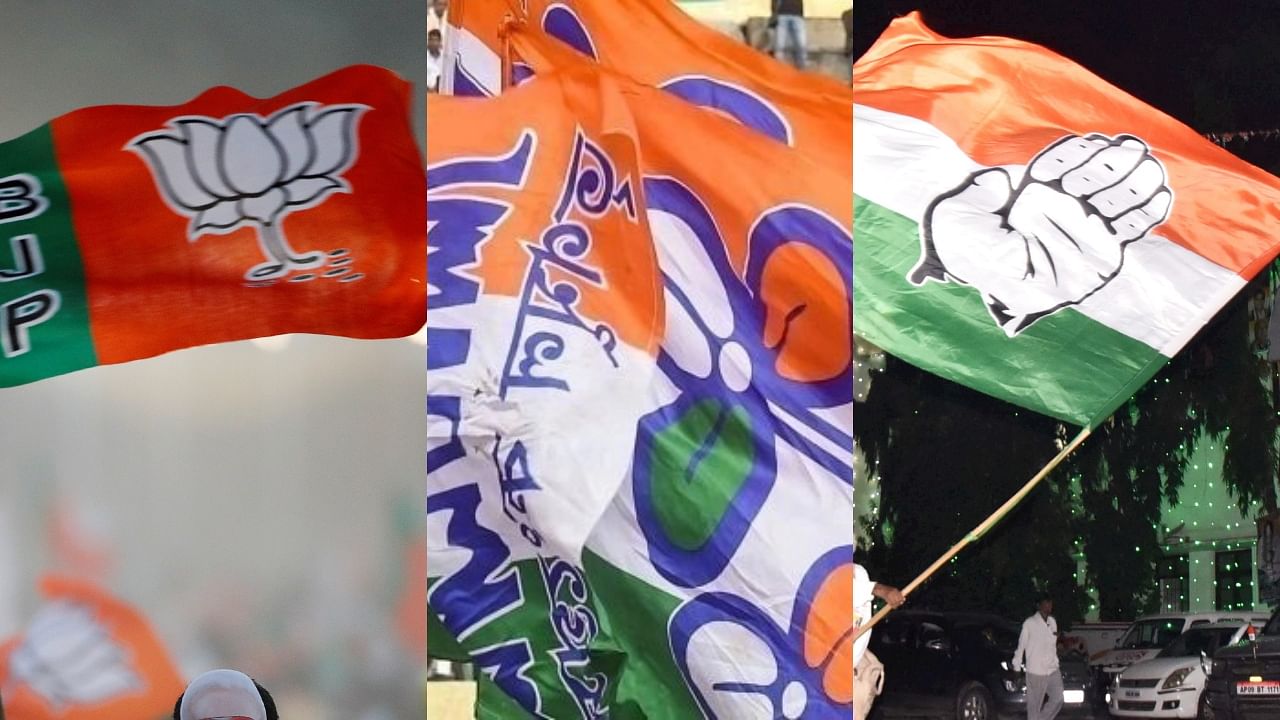
BJP, TMC, Congress flags.
Credit: PTI, Reuters Photos
Kolkata: As the final five phases of polls draw closer, rift among INDIA bloc partners, Congress-Left combine and the TMC, which are fighting separately has intensified, triggering a fierce contest across half of the remaining 36 constituencies in West Bengal driven by local issues such as Sandeshkhali and the SSC scam.
TMC's decision to contest independently in the state, rather than as part of the bloc, has led to a three-way contest, with the other contenders being the BJP and the Congress-Left alliance.
Nevertheless, both TMC and Congress have asserted that they are part of the I.N.D.I.A. bloc at the national level and are authentic representatives of the opposition front in Bengal.
Political analysts suggest that without a dominant national narrative like national security after the 2019 Pulwama attacks, local concerns such as corruption allegations, the cancellation of School Service Commission (SSC) jobs, incidents in Sandeshkhali and implementation of the Citizenship Amendment Act (CAA) are altering election dynamics.
Maidul Islam, a political scientist at the Centre for Studies in Social Sciences, remarked, "Till a few months ago, it seemed the elections in Bengal will be a bipolar contest between the TMC and BJP. But with issues like corruption and Sandeshkhali gaining prominence, the Left-Congress alliance is fast gaining traction in several seats and turning the polls into a three-cornered contest in at least 18-20 LS segments."
He said besides the two and three seats in Malda and Murshidabad districts, where TMC and Congress secured two each and the BJP one in 2019, there are 13 seats spread across South Bengal, where the TMC and the Left-Congress alliance are engaging in intense competition.
"It's not that the Left-Congress will win many seats, but in segments where their vote share is above 10 per cent, there is a likelihood that they might influence the outcome, to the disadvantage of either the TMC or the BJP, if they manage to secure two per cent more votes," Islam added.
According to sources in TMC and CPI(M), the electoral battleground extends beyond Malda and Murshidabad, encompassing Lok Sabha segments like Dum Dum, Srerampore, Arambagh, Hooghly, Howrah, Barrackpore, Bardhaman-Purba, Bardhaman-Durgapur, Bankura, Purulia, Tamluk, Kolkata North, and Jadavpur, all poised for a three-cornered fight.
Notably, eight of these seats were won by TMC and the remaining by BJP in the 2019 parliamentary polls.
"The shift in dynamics presents the Congress-Left alliance as a significant player, and its emergence complicates the electoral narrative, transcending the conventional TMC versus BJP dichotomy," political analyst Subhomoy Moitra said.
While the Left Front is contesting 30 seats, the Congress has fielded candidates in 12 out of 42 seats.
"We wanted an alliance with the Congress, but they were delaying the seat-sharing arrangements, so we decided to go alone. Now the Left-Congress alliance is helping the BJP by trying to eat into our votes," remarked TMC leader Santanu Sen.
According to TMC leaders, the breakup of I.N.D.I.A. alliance in Bengal has both electoral advantages and disadvantages.
"After the Left and Congress alliance fell apart in West Bengal in 2019, it had led to a four-cornered contest with BJP bagging the entire chunk of the anti-TMC votes in the state," they said.
In the 2019 Lok Sabha elections, the BJP bagged 18 seats and its vote share rose from 17 to 40 per cent.
Meanwhile, despite a 3 per cent rise in vote share, the TMC lost 12 seats, dropping from 34 to 22. The Left drew a blank with a vote share decline from 24 per cent to 6 per cent, and the Congress lost two seats, shrinking its vote share from 9.5 per cent to 5 per cent and bagging just two seats.
"Local issues such as corruption and SSC scam are helping the Left-Congress in the state as there is anger among a section of people against the TMC and also against the BJP over the perception of a tacit understanding," a TMC leader said.
Analysts observe that Mamata Banerjee's intensified criticism of Left and Congress, accusing them of aiding BJP, and the ensuing sharp responses from CPI(M) and Congress, alleging a secret pact between TMC and BJP, as indicative of the growing significance of Left-Congress alliance.
Data from various local elections and by-polls conducted after 2021 assembly elections indicate a shift in anti-TMC votes as there has been a resurgence of Left-Congress combine.
Incidentally, the BJP had witnessed a decline in its vote share as compared to the 2019 Lok Sabha and 38 per cent in 2021 assembly polls.
In 2023, violence scarred panchayat polls which covered nearly 70 per cent of the state’s electorate, the TMC had bagged 51 per cent of votes whereas the BJP had bagged 22 per cent.
The Left-Congress-ISF alliance had, however, bagged 23 per cent votes. The ISF this time, however, has decided to contest alone in 17 seats.
Congress leader Suvankar Sarkar emphasized, "People are disenchanted with the TMC and the BJP, as they are both sides of the same coin. People are coming out in large numbers to support the Left-Congress candidates."
CPI(M) leader Sujan Chakraborty expressed confidence in the Left-Congress alliance's potential to deliver surprising results in the elections, claiming initial success in breaking bipolar politics in Bengal.
BJP state president Sukanta Majumdar downplayed the significance of the rift in opposition alliance and the three-cornered fight in various seats.
"People know that BJP is only fighting TMC's misrule in Bengal. Those who want to vote against TMC, will vote for us only just like in the 2019 and 2021 polls," he said.
Political scientist Biswanath Chakraborty suggested that TMC stands to gain the most from the three-cornered contest.
In minority pockets, the Left-Congress alliance could dent TMC's vote base, potentially aiding BJP's prospects, he noted.